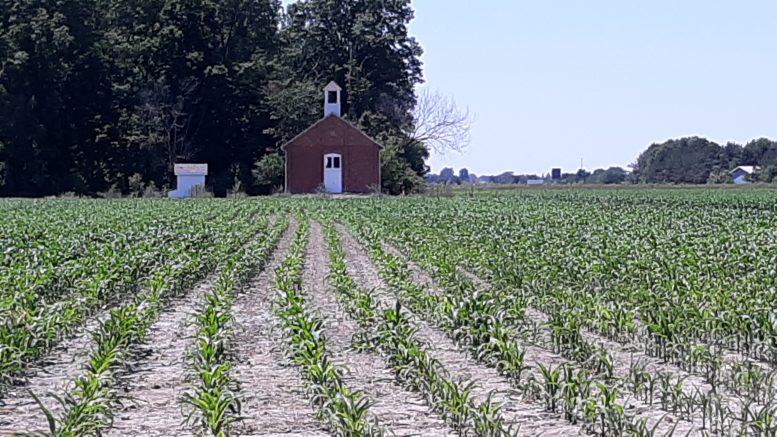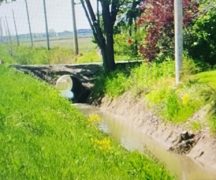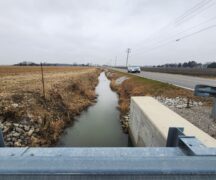By JAN LARSON McLAUGHLIN
BG Independent News
It’s months since fields were harvested, and months until new crops will be put in the ground. But local farmers still have worries in the midst of the cold dormant winter.
Earlier this week, seven farmers and three staff from the Wood Soil and Water Conservation District gathered to talk over concerns. The monthly “From the Farm” gatherings take place at farms in the warmer months, but this week’s was held in a Bowling Green restaurant.
Winter is a time for equipment repairs and preparing to get back in the fields to plant.
“They are making plans for next year,” said Sarah St. John, district technician with Wood Soil and Water Conservation.
On their minds this week were cover crops – the local struggles and success stories.
Cover crops are one of the 10 practices promoted in the state’s H2Ohio program aimed at reducing the amount of phosphorus running off fields into ditches and streams as they drain into Lake Erie.
When planted after the main harvest, cover crops reduce erosion, hold nutrients in the soil, and improve soil health, St. John explained.
There are roughly 72,000 acres enrolled in H2Ohio in Wood County. That’s about 27% of the 268,767 acres of farmland in the county, according to the National Agriculture Statistics Service 2017 Ag Census.
Cover crops are not necessarily intended to be harvested, but rather to grow through the winter and put organic matter back in the soil.
The harvest of crops such as corn or soybeans, usually means the soil surface of a field will be left bare until the next crop is planted and a new plant canopy is established.
That means it could be five to seven months that bare fields are subjected to erosion caused by rainfall, snowmelt or wind. So cover crops are usually established and grown in the fall months, and remain throughout the winter. In the spring, most are then killed and left on the surface as residue for conservation tillage or are incorporated into the soil.
“They help with soil health and with erosion,” St. John said.
Some of the more popular cover crops in Wood County are cereal rye, clover and radishes, according to St. John.
While cover crops are catching on in some fields, they are proving to be more stubborn in others. It didn’t help that planting time last year was limited due to the late fall harvest.
“This fall was difficult for a lot of producers because it was so wet,” St. John said.
Some local farmers discussed the option of aerial applications, so heavy farm equipment wouldn’t have to drive on the soggy fields.
In the spring, some crops can be planted into the cover crops, while some farmers choose to spray herbicide to kill off the cover before planting their summer crops.
According to the Sustainable Agriculture Research and Education, cover crops should be viewed as a long-term investment in improved soil health and farm management. They can begin to pay for themselves in the first year of use, or it may take a few years for them to lead to a net positive return.
In addition to slowing erosion and improving soil health, cover crops can also enhance water availability, smother weeds, help control pests and diseases, and increase biodiversity.
Cover crops have been shown to increase crop yields, break through a plow pan, add organic matter to the soil, improve crop diversity on farms and attract pollinators.
There is also increasing evidence that growing cover crops increases resilience in the face of erratic and increasingly intensive rainfall, as well as under drought conditions. Cover crops help when it doesn’t rain, when it rains, and when it pours.
Following is a list of benefits from planting cover crops:
- The protective canopy formed by a cover crop reduces the impact of rain drops on the soil surface thereby decreasing the breakdown of soils aggregates. This greatly reduces soil erosion and runoff, and increases infiltration. Decreased soil loss and runoff translates to reduced transport of valuable nutrients, pesticides, herbicides, and harmful pathogens associated with manure from farmland that degrade the quality of streams, rivers and water bodies and pose a threat to human health.
- A cover crop slows the velocity of runoff from rainfall and snowmelt, reducing soil loss due to erosion.
- Over time, a cover crop regimen will increase soil organic matter, leading to improvements in soil structure, stability, and increased moisture and nutrient holding capacity for plant growth. These properties will reduce runoff through improved infiltration and percolation.
- A cover crop will increase soil quality by improving the biological, chemical, and physical soil properties.
- As a “trap crop,” a cover crop will store nutrients from manure, mineralized organic nitrogen or underutilized fertilizer until the following year’s crop can use them, reducing nutrient runoff and leaching.
- When a cover crop is managed for its contribution to soil nitrogen, the application of a nitrogen fertilizer for the subsequent crop may be less, thereby lowering costs of production, reduced nitrogen losses to the environment and reducing the use of purchased nitrogen fertilizer that is produced using fossil fuels.
- Cover crops will reduce or mitigate soil compaction. Deep tap roots of some cover crops grown in the fall and spring when compacted layers are relatively soft and can penetrate these layers.
- Cover crops can create improved soil structure and stability, and can improve the soil’s capacity to withstand heavy farm equipment, resulting in less subsurface compaction.
- A cover crop provides a natural means of suppressing soil diseases and pests. It can also serve as a mulch or cover to assist in suppressing weed growth.
- A cover crop can provide high-quality material for grazing livestock or haying and can provide food and habitat for wildlife, beneficial insects, and pollinators.
The last signup for H2Ohio in Wood County closed on Jan. 15, but if local farmers want to receive updates and information about future sign ups, they can contact the Wood Soil and Water Conservation District.
If farmers are interested in programs like EQIP (Environmental Quality Incentives Program through Natural Resource Conservation Service – https://www.nrcs.usda.gov/wps/portal/nrcs/main/national/programs/financial/eqip/) they can contact the office to speak to local NRCS staff about submitting an application anytime.
The USDA recently announced the next Conservation Reserve Program (CRP) general sign up period, which will run from Jan. 31 to March 11. Interested landowners can contact the Farm Service Agency for more information.




